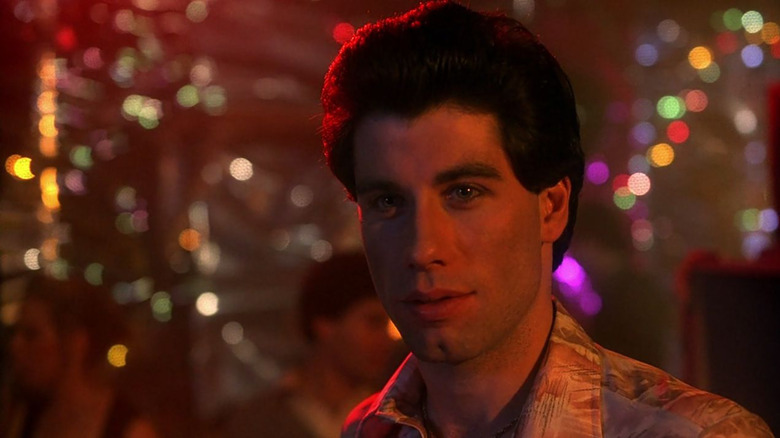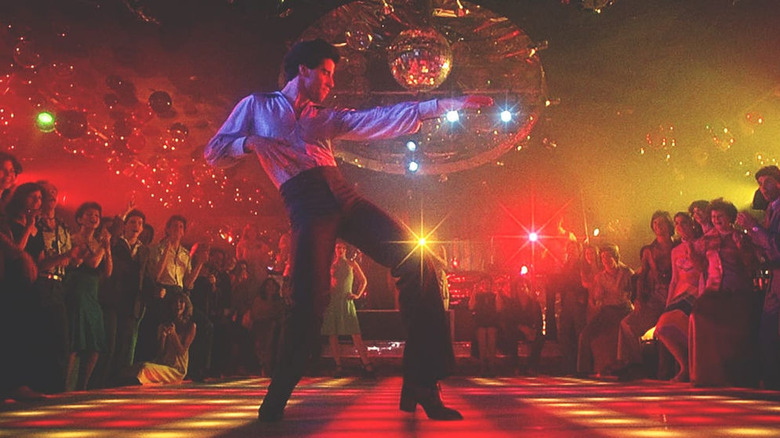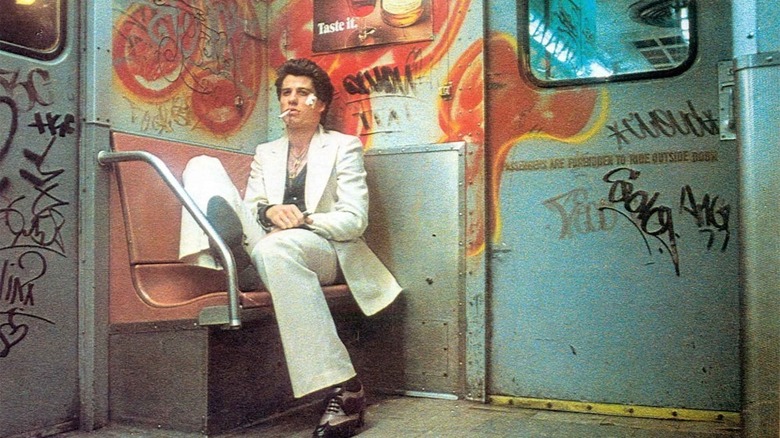John Travolta's Reputation Threw A Wrench In His Research For Saturday Night Fever
Tom Hanks. Michael J. Fox. George Clooney. Jennifer Aniston. Kristen Wiig. These are just a few of the actors that managed to make the transition from television to movies, but John Travolta made the move before each of them. In 1976, producer Robert Stigwood took a very big gamble on the young TV star, signing Travolta to a million-dollar contract to star in three feature films. The movie version of the hit Broadway musical "Grease" was slated to be the first project to launch Travolta into a full-fledged leading man, but the musical was still so popular, production on the film wasn't allowed to begin until 1978.
While Manhattan was still stuck in the swinging sixties, disco was happening in the other four boroughs. The underground movement inspired an English rock critic named Nik Cohn to write an article in New York magazine focusing on the blue-collar Italian kids in Bay Ridge, Brooklyn that were lighting it up on the dance floor. The article entitled "Tribal Rites of the New Saturday Night" was a sensation, attracting producers to bid on the rights to the article with the intent of turning it into a music-driven drama that could capitalize on the new craze before it fizzled out. At the time, it was virtually unheard of to make an entire movie based on an article, but now it happens all the time.
According to Vanity Fair, Cohn was paid $90,000 for the rights and the search for a director began. John Badham eventually signed on with screenwriter Norman Wexler ("Serpico") attached. Travolta came aboard and suddenly had his first star vehicle. As Vinnie Barbarino on "Welcome Back Kotter," Travolta was already nationally known when he started going to disco clubs for research, which didn't exactly help him blend in.
2001 a dance Odyssey
At the famed discotheque 2001 Odyssey in Bay Ridge, a group of dancers became known as the Faces. They were regular guys in dead-end jobs during the week, but inside the club, they were celebrities. For research (and probably a little bit of fun), Travolta started sneaking into 2001 Odyssey only to be instantly recognized by all of the kids inside. His character Vinnie Barbarino in "Welcome Back Kotter" already felt like he was one of them. To actually be able to investigate the scene, Travolta was forced to wear dark glasses and a hat as a disguise.
For anyone that's ever been in the same public place as a celebrity, word gets around fast. Getting spotted out on the town can turn into a situation quickly, especially in South Brooklyn during the late '70s. Fortunately, Travolta was able to study the behavior and dance moves of the Faces dancers enough to base his character's brashness on how confidently they peacocked around the club. "Their girlfriends would come up, and they'd say, 'Hey, stay away from him, don't bug Travolta,' and they'd actually push the girls away," Travolta told Vanity Fair. "Tony Manero's whole male-chauvinist thing I got from watching those guys in the discos."
The character of Tony was reportedly based on Vincent, the dancer and leader of the Faces who had appeared on "American Bandstand." Vincent worked at a hardware store selling paint, just like Tony in "Saturday Night Fever." When he was dancing at 2001 Odyssey, Vincent was once even mistaken for Al Pacino. Of course, the poster for "Serpico" hangs in Tony's room while he gets ready to go out on the town.
The real NYC in Saturday Night Fever
In a bizarre New York connection, Lloyd Kaufman — co-founder of the indie horror company Troma responsible for "The Toxic Avenger" — was in charge of finding the locations for "Saturday Night Fever." Kaufman looked everywhere for the right spot. "We looked at every disco in Manhattan, Brooklyn, and Queens," he said, "and even considered converting a loft to our own specifications, before deciding to go with 2001 Odyssey, in Bay Ridge. That was always our first choice, since that's where the story really happens."
When the production finally got underway using 2001 Odyssey as its main location, camera operator Tom Priestley Jr. remembers being a little concerned about the reaction they would receive from the neighborhood. "I would've thought the real guys would have resented a film like this, like we've come to make fun of them or something, but they loved it." Priestley recalled some of the real dancers that wound up in the background, saying, "There was one brother-and-sister team that was very good. Remember, all those people in the show are extras."
On the first day of filming, over 10,000 kids were in the streets and the production only had four security guys. One night, a firebomb was thrown into the club that luckily didn't ignite any pompadours. Brooklyn was a dangerous place back then, and the neighborhood youth wanted to be featured in the movie. The dance floor was a true form of escapism for the character of Tony and the real-life dancers that flocked there every Saturday. Every time they exited 2001 Odyssey, though, the real New York City came barreling in to bring everyone back down to reality.


